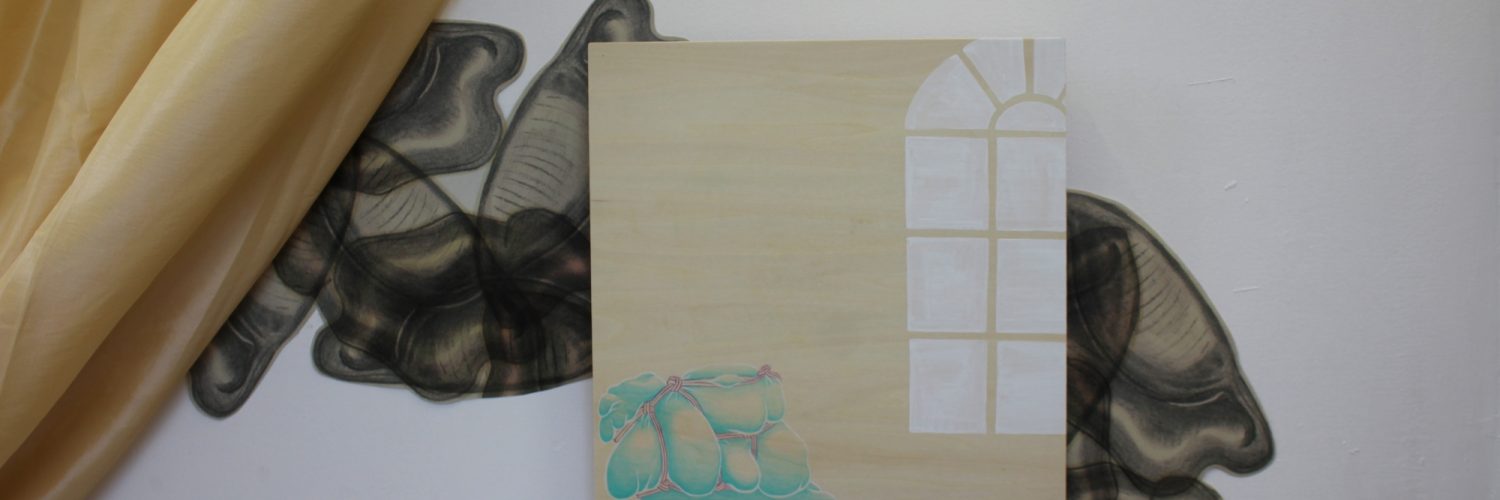
'The Melting/ed' Spring in CCA Project Space

Artist Tara McGinn spent four weeks working in CCA's Project Space over March and April 2022. Over the month Tara visited old sketch books, examined previous research and experimented with new materials. In this cathartic process of familiarising herself with different ways of making and destroying ideas in the studio, she has created an installation as a snapshot of the work, visible from the gallery's windows at 10–12 Artillery Street. Tara's time in the CCA Project Space has culminated in The Melting/ed Spring, which you can see in our windows until Sunday 1 May 2022. She will be developing a written piece informing a new audiovisual work based on the developments in her practice over the course of the residency which will be produced later in the Summer.
I
"The melting process begins with a tentative and nearly unseen activity, proceeds through a state of serious business, and culminates in an onrush of furious and sloppy abandon." John Miller, March 29 - 1984. https://www.gi.alaska.edu/alaska-science-forum/spring-melting-processI had visualised this period of respite and recovery for my practice to be reparative. Similarly to the way you renovate and rebuild a structure after an extended period of neglect - removing any sign of decay or destruction and replacing them with reassuring signs of maintenance and care. Through repeated bus journeys on the 212 and retracing my steps around the endless city hills; this notion developed cracks that no amount of poly filler would smooth over. I came to realisations without really realising anything. I found myself returning to a place I had been to before, that I didn't think I would find again, and found that it could still be so generous and forgiving after my re-acquaintance with it.
II
I read about trauma and it's antagonist role in the body, I read about an artist who spent her entire career making work of her traumas, I made a list of the words that both texts used. I drew the print like shapes of the sash windows that the sun spread across the walls of the project space whenever it shone, I drew just so I could draw again, I remembered that I was always good at it. I embroidered because I had done that in the past too, I embroidered perfect cursive lettering of sexual fetish into salmon coloured velvet, I overheard the woman in the haberdashery talk about how the price of dressmaking doesn't make up for the labour and materials: she tells girls to go to Primark instead. I wrote every thought that came into my head, I wrote about my own exhaustion from my writing, I used to win prizes in primary school for my excellent handwriting when I thought I was just copying shapes. I watched Youtube videos on trauma core aesthetics, liminal space compilations and dream pools, I watched video game walkthroughs of indie Japanese horror games so that I wouldn't have to concentrate on what I was doing, I could feel my body wilting on days like this. I sat everyday in the same spot of a closed off room with windows for others to look in at, I became physically static and emotionally activated, I looked through the glass and fantasised about the view from the other side to shape my installation.
III
The daffodils (botanical name: narcissi) had sprung and gilded the hills in a bright, yellow gold for the four weeks of the residency. They are sprightly, buttery things that symbolise to us the delicate, annual ascension of temperature after winter. They arrived early and lasted longer this year; the climate change creep effect that will force us to re-associate our idea of daffodils as Christmas flowers. This reversal and erasure of significance is synonymous with the flower's Greek mythological origins: Narcissus fell in love with their own reflection in the water and was turned into what is described as a "strange, pallid, ghostly flower". The name "daffodil" is derived from the flower of the Apshodel Meadows (the afterlife for plebs/working class folk) whom were obliged to drink from the River Lethe as they entered and ultimately had their identity stripped from them. This immediately brought my mind to the Wordsworth poem, and I considered his view from above as a mindless cloud, observing fields of happy, golden dummies. "Identity formation is inextricably linked to the urge to consume, and therefore the acceleration of capitalism necessitates an increase in the rate at which individuals assume and shed identities. The internet is one of many late capitalist phenomena that allow for more flexible, rapid, and profitable mechanisms of identity formation." Jonah Peretti, Capitalism and Schizophrenia.
Tara is an interdisciplinary artist originally from Enniscorthy and is a former co-director at Catalyst Arts and studio member of Flax Studios in Belfast. Her work combines sculptural (re)production, image-based assemblage and writing. Her developing studio processes aim to connect, contrast and translate subjects of trauma, memory, identity and space. Recent exhibitions include Woman in the Machine at VISUAL Carlow, and her solo show Nothing Alien is Human to Us at Platform, Belfast. She was part of CCA's Window Texts 2021 series with Mincers, designed by Reece Kennedy.
Tara was invited to occupy the CCA Project Space as part of her participation in the PS² Freelands Foundation Programme. Fellow programme artists will feature in the CCA Project Space later in the year.
Supported by the National Lottery through the Arts Council of Northern Ireland and Derry City & Strabane District Council.

More Public Programmes















